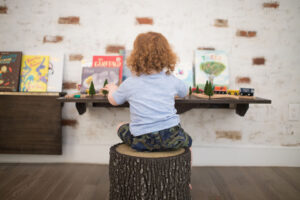First time separation is a major milestone for parent and child alike. It can be a cause of nervousness, anxiety, and an ever-changing array of emotions. Luckily, there are many ways to ensure that first-time separation is a success for both you and your little one!
And as you begin this process, there is something that every parent should know:
When handled with kindness and care, first-time separation can be a joyous and exciting experience.

Separation is innately emotional, but it’s also tremendously rewarding. At Wise Wonder, we strive to support parents and children as they navigate the challenging aspects of separation, while also celebrating the joy of the experience and the important milestone that it is. Through our methods of soft separation, we offer an approach to separation that promotes confidence and comfort for both parent and child.
Wise Wonder Enrichment’s “grown-up & me” classes run from 3-26 months, and our separation classes begin at 18 months, so we are up close and personal with separation anxiety and the first time separation process.
At Wise Wonder, we encourage parents to have grace for their child’s feelings, as well as their own. Separation is not a single moment, but a process. Some children are ready to separate right away and head into class without a second glance, while others need more time to acclimate. There’s no right way to separate — it’s all about reading your child and finding ways to make them as comfortable as possible. Soft separation prompts parents to accompany their child into their class space, introduce them to the environment and new faces, and then remove themselves when their child is more at ease.
Here are some of our favorite tips and reminders when embarking on the journey of first-time separation:
Negative emotions are a natural part of the process.
Babies can start showing signs of separation anxiety at as early as 4-5 months, but many children display greater signs around 14-18 months and into toddlerhood. At this point, they have developed “object permanence,” which is the ability to know of an object’s existence even when it cannot be seen or heard. Therefore, a child begins to understand that not seeing mom and dad means they have gone somewhere else. This can trigger feelings of fear, anxiety, and confusion. And your child won’t be the only one experiencing those emotions. Hearing your little one in pain can be heart-wrenching. It can bring up a sense of guilt and make you feel like you are letting your child down.
But this is not the case at all. In fact, these negative emotions are one of the most important parts of separation. You’re teaching your child to work through adversity. You are giving them the chance to learn that difficult emotions pass and they are capable of both feeling and overcoming them.
Consistency is key.
A main reason first-time separation is so overwhelming for a child is because they don’t yet understand that their grownup will come back. In order to learn this, consistency is key. You want to show your child that, though you leave, you will always come back. It is important to be clear and direct with your child and to explain time in a way they understand. For example, when saying goodbye, you can reassure your child that you will be back to pick them up right after snack or storytime. When you are consistent with this promise, your child will pick up on the pattern. They will know what to expect and separating won’t feel so overwhelming because they will have seen repeated proof that you came back.
Practice makes progress.
Practice, practice, practice. The separation process begins well before dropping off your child on day one.
Whether it’s pre-school, a prep class, camp, or a friend’s house, talk to your child about what they will be doing and where they will be going. You can also instill the idea of separation through fun games. For example, you can play pretend by dropping their favorite stuffed animal off at “school” and picking them up again just when you said you would. If you’re able to, you can even connect with the parents of another child in their class and schedule a playdate before the first day. And of course, you can always turn to the power of stories. It is extremely helpful to read books about school and separation that will prepare and excite your child.

Here are 5 Wise Wonder recommendations to read to your little one:
- A Tiger Tail (or What Happened to Anya on Her First Day of School) by M. Boldt
- All Are Welcome by Alexandra Penfold and Suzanne Kaufman
- School’s First Day of School by Adam Rex and Christian Robinson
- The Day You Begin by Jacqueline Woodson and Rafael Lopez
- My First Day by Phung Nguyen Quang and Huynh Kim Lien
Safe space.
Separation is difficult anywhere, but it’s especially difficult in a new place with new people. Dropping your child off in an unfamiliar classroom setting with other children and grownups is far different from leaving your child at home with grandma. Therefore, adjusting to the environment is key. If you can, meet with teachers and tour the space before the first day of class. Whenever you walk or drive by the school, camp, or class location, point it out to your child to begin establishing a sense of place. Then, on your first day, be sure to settle your child in the space before separating. If you show your child that you feel safe in a space, they will be more likely to as well.
But it isn’t simply about being familiar with the environment, it’s about the type of environment you choose. At Wise Wonder we understand that schools and daycares can be large, overwhelming places to separate for the first time, so we have created a cozy and serene space meant to both calm and stimulate your little one’s mind. We have a living room when you first enter Wise Wonder where we invite parents to stay and wait for their children — particularly when a little one is first separating. It’s an extremely beneficial aspect of the separation process, as we are able to move from the living room to our classroom and help our students understand that while they’re in class, their caregiver is still nearby.

The front room and hallways that lead from our living room to our classrooms are filled to the brim with books, trinkets, pictures, and more. These extras not only add a sense of coziness to our little nook, but also provide opportunities for our educators to distract children who may be having trouble separating. Sometimes it is as simple as pulling out a pop-up book, or looking for all the owls to help ease a child’s anxiety. The environment instills a kind of wonder in learning and allows children to feel happier and more excited in the space.
The materials present in class is another factor. In the weeks before and during separation it’s important to pay attention to the things that best soothe and engage each child. Whether it’s stickers, water color, or dot paint, the teacher can then highlight this activity or material to motivate the students and allow them to begin associating that happiness and comfort with the class itself. Nurturing happiness and cultivating joy will not only help with separation, but instill an early and lifelong love of education.
Remember, separation is not one size fits all. It’s a unique process for everyone, so have grace and patience for both yourself and your child. Here’s to taking the first step to becoming independent learners, readers, dreamers, and doers!
